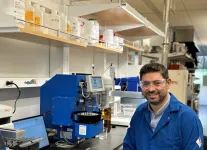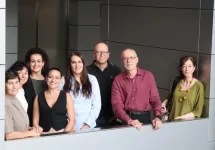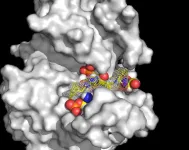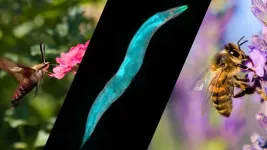(Press-News.org) Osaka, Japan – Plastics underpin much of modern life—areas like medicine, technology, and food safety would be unrecognizable without plastics and their useful properties. However, the toughness of plastics, which is often desirable, also makes them a dangerous pollutant and difficult to recycle. The solution to this serious and growing problem is making plastics easier to recycle.
In a study recently published in Chemical Science, researchers at Osaka University have found a way to make tough, high-performance polymers, the main component of plastics, that can be broken down easily and precisely into their component parts and recycled into materials that are like new.
The main component of plastics are molecules called polymers, which are long chains of small repeating units called monomers. Current physical recycling simply reuses the polymers without breaking them down, and the recycled plastic is usually worse than the original. Chemical recycling is a newer method that breaks the polymer chains back down into their monomer units and then strings the units back together. The recycled plastic is as good as new. However, the polymers designed for chemical recycling are usually weak because they have weak links between the monomer units so that it is easy to break the chains up.
The researchers have developed a way to make tough, chemically recyclable polymers without compromising on heat and chemical resistance. This breakthrough could hugely expand the uses of chemically recyclable polymers.
“We knew that we needed to make the links between the monomers really strong in harsh environments but easily broken under specific conditions for recycling,” says lead author Satoshi Ogawa. “We were surprised to find that no one had tried including a directing group, which would break the strong links only in the presence of a metal catalyst.”
The directing group is like a lock on the link, only opening the link when the right key is present. The polymers stood up to high temperatures and harsh chemicals, but when it came to recycling, a nickel catalyst acted like a key, and the directing group opened the links easily, releasing the monomers. The original polymer could then be reassembled from the monomers.
“It’s a huge step forward to make a polymer this tough that can be broken down easily and precisely and recycled into a pristine material in so few steps,” explains senior author Mamoru Tobisu. “This revolutionary design could be used in making high-performance polymers that can be recycled indefinitely with no loss of quality.”
The team’s work shows that there doesn’t have to be a tradeoff between performance and recyclability. Their design could be used in lots of other polymers to make many types of plastic chemically recyclable, potentially helping to consign plastic pollution to the trash can of history.
###
The article, “Controlled Degradation of Chemically Stable Poly(aryl ethers) via Directing Group-Assisted Catalysis,” was published in Chemical Science at DOI: https://doi.org/10.1039/d4sc04147j
About Osaka University
Osaka University was founded in 1931 as one of the seven imperial universities of Japan and is now one of Japan's leading comprehensive universities with a broad disciplinary spectrum. This strength is coupled with a singular drive for innovation that extends throughout the scientific process, from fundamental research to the creation of applied technology with positive economic impacts. Its commitment to innovation has been recognized in Japan and around the world. Now, Osaka University is leveraging its role as a Designated National University Corporation selected by the Ministry of Education, Culture, Sports, Science and Technology to contribute to innovation for human welfare, sustainable development of society, and social transformation.
Website: https://resou.osaka-u.ac.jp/en
END
New polymer design breaks the tradeoff between toughness and recyclability
Researchers from Osaka University design high-performance polymers that are broken down easily with a catalyst and recycled into pristine polymers, showing that plastics can be both tough and recyclable
2024-10-07
ELSE PRESS RELEASES FROM THIS DATE:
Tax, smoke-free legislation, and anti-smoking campaigns linked to smoking reduction
2024-10-07
Tobacco use remains a significant global health challenge, despite extensive control measures at both national and international levels. Smoking continues to be a leading cause of premature death, with exposure to tobacco—whether through active smoking or secondhand smoke—significantly increasing the risk of non-communicable diseases (NCDs) such as cardiovascular disease, cancer, chronic respiratory conditions, and diabetes. These NCDs account for nearly 75% of annual global deaths.
A wide range of strategies has been developed to combat smoking and promote public health, including taxation, mass media campaigns, health warnings on packaging, marketing ...
Targeting failure with new polymer technology to enhance sustainability
2024-10-07
Targeting failure with new polymer technology to enhance sustainability
Sustainability is a complex problem with many different players and influenced by policies, society, and technical perspective.
We are reminded every day in the media of the unnecessary amount of waste that we are generating with pervasive pictures of plastic garbage patches floating in the oceans or stranded on our beaches.
Scientists within ASU’s School of Molecular Sciences (SMS) and the Biodesign Institute’s Center ...
Stigma has a profound impact on health outcomes must be addressed
2024-10-07
A new article published in Nature Reviews Disease Primers underscores the profound role that stigma can play in health care -- and how addressing stigma-related barriers can significantly improve health outcomes for individuals and communities around the world.
“Stigma has harmful effects on health, equity and justice,” says lead author Carmen Logie, a professor at the University of Toronto’s Factor-Inwentash Faculty of Social Work (FIFSW). "And while we need more rigorous evaluation of interventions ...
Has the affordable care act’s dependent coverage expansion benefited young adults diagnosed with cancer?
2024-10-07
The federal Patient Protection and Affordable Care Act (ACA) passed in 2010 includes a Dependent Coverage Expansion (DCE) provision that permits dependents to remain on their parents’ health insurance plans from age 19 to 25 years, the age group that has historically had the highest uninsured rate in the United States. A recent analysis reveals that during the ACA’s first decade, survival rates of DCE-eligible young adults with cancer have improved. The findings are published by Wiley online in CANCER, a peer-reviewed journal of the American Cancer Society.
To examine whether young adults with cancer diagnoses have ...
A new study reveals a key mechanism driving atherosclerosis in Hutchinson-Gilford Progeria Syndrome
2024-10-07
A team of researchers from the Centro Nacional de Investigaciones Cardiovasculares Carlos III (CNIC), the Centro de Investigaciones Biológicas Margarita Salas (CIB-CSIC), and the Instituto de Ciencias de Materiales de Madrid (ICMM-CSIC) has made a significant breakthrough in understanding the underlying causes of cardiovascular disease in patients with Hutchinson-Gilford progeria syndrome (HGPS), an ultra-rare genetic disorder that accelerates the aging process. The most serious consequence of HGPS is the early onset of cardiovascular disease, leading to premature death at an average age of 14.5 years.
The study was led by Dr. Vicente Andrés, ...
HPV vaccination switch to 1-dose gender-neutral approach
2024-10-07
Canadian vaccination programs could switch to a 1-dose gender-neutral human papillomavirus (HPV) vaccination approach and eliminate cervical cancer, suggests new modelling in CMAJ (Canadian Medical Association Journal) https://www.cmaj.ca/lookup/doi/10.1503/cmaj.240787.
“Our results have important policy implications in Canada, and in other similar high-income countries evaluating whether to switch to 1-dose HPV vaccination,” writes Dr. Marc Brisson, a full professor at Laval University, Québec, and director of the Mathematical Modeling and Health Economics of Infectious Diseases Lab at the ...
Scurvy: Not just an 18th-century sailors’ disease
2024-10-07
Scurvy, or vitamin C deficiency, is not just an 18th-century seafarers’ disease, as a case study of a 65-year-old woman with mobility issues and social isolation shows. In an article published in CMAJ (Canadian Medical Association Journal) https://www.cmaj.ca/lookup/doi/10.1503/cmaj.240769, clinicians describe how scurvy should be considered in patients with abnormal bleeding and nonspecific symptoms.
The patient visited the emergency department at a downtown Toronto hospital for leg pain and weakness, skin lesions, and discoloration. She also had several chronic health ...
Scientists discover a secret to regulating our body clock, offering new approach to end jet lag
2024-10-07
Singapore, 7 October 2024—Scientists from Duke-NUS Medical School and the University of California, Santa Cruz, have discovered the secret to regulating our internal clock. They identified that this regulator sits right at the tail end of Casein Kinase 1 delta (CK1δ), a protein which acts as a pace setter for our internal biological clock or the natural 24-hour cycles that control sleep-wake patterns and other daily functions, known as circadian rhythm.
Published in the journal PNAS, their findings could ...
Impact of pollutants on pollinators, and how neural circuits adapt to temperature changes
2024-10-04
The Kavli Foundation and the U.S. National Science Foundation are collaborating to accelerate research in the emerging field of neurobiology in changing ecosystems, stemming from the foundation’s efforts in this area first announced in 2023. A joint Kavli-NSF grantmaking program was launched in December of 2023.
Building on early success of this program, Kavli and NSF announce its continuation with a second call for proposals, open through February 10, 2025, for projects tackling hard problems in this understudied field.
Research ...
Researchers seek to improve advanced pain management using AI for drug discovery
2024-10-04
An estimated one in five Americans live with chronic pain and current treatment options leave much to be desired. Feixiong Cheng, PhD, Director of Cleveland Clinic’s Genome Center, and IBM are using artificial intelligence (AI) for drug discovery in advanced pain management. The team’s deep-learning framework identified multiple gut microbiome-derived metabolites and FDA-approved drugs that can be repurposed to select non-addictive, non-opioid options to treat chronic pain.
The findings, published in Cell Press, represent one of many ways the organizations' Discovery Accelerator partnership is helping ...
LAST 30 PRESS RELEASES:
Electrodes created using light
Second-hand gift-giving is a well-deliberated decision
How human interaction drove evolution to make bears less aggressive
National Poll: Few parents offer teens guidance on healthy eating during holiday season
Cannabis derivatives could provide new ovarian cancer treatments
Raising strong yeast as a petroleum substitute
Clues to the origin of hot Jupiters hidden in their orbits
Canada’s reduced pledge to Global Fund will impact domestic health
1 in 4 children with major traumatic injuries not cared for in pediatric trauma centres
Duke and Duke-NUS’ joint cross-population research to uncover "East-West" differences in disease and care
Scientists to ‘spy’ on cancer- immune cell interactions using quantum technology breakthrough
Tech savvy users have most digital concerns
Making lighter work of calculating fluid and heat flow
Normalizing blood sugar can halve heart attack risk
Lowering blood sugar cuts heart attack risk in people with prediabetes
Study links genetic variants to risk of blinding eye disease in premature infants
Non-opioid ‘pain sponge’ therapy halts cartilage degeneration and relieves chronic pain
AI can pick up cultural values by mimicking how kids learn
China’s ecological redlines offer fast track to 30 x 30 global conservation goal
Invisible indoor threats: emerging household contaminants and their growing risks to human health
Adding antibody treatment to chemo boosts outcomes for children with rare cancer
Germline pathogenic variants among women without a history of breast cancer
Tanning beds triple melanoma risk, potentially causing broad DNA damage
Unique bond identified as key to viral infection speed
Indoor tanning makes youthful skin much older on a genetic level
Mouse model sheds new light on the causes and potential solutions to human GI problems linked to muscular dystrophy
The Journal of Nuclear Medicine ahead-of-print tip sheet: December 12, 2025
Smarter tools for peering into the microscopic world
Applications open for funding to conduct research in the Kinsey Institute archives
Global measure underestimates the severity of food insecurity
[Press-News.org] New polymer design breaks the tradeoff between toughness and recyclabilityResearchers from Osaka University design high-performance polymers that are broken down easily with a catalyst and recycled into pristine polymers, showing that plastics can be both tough and recyclable




